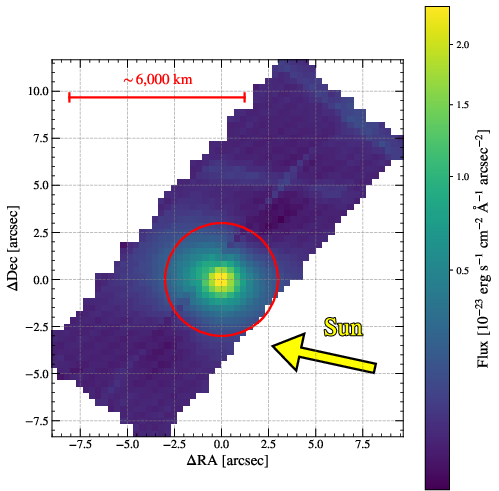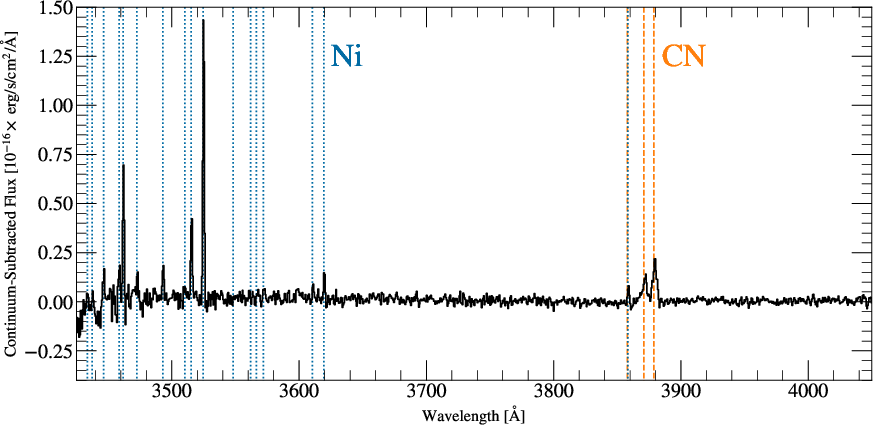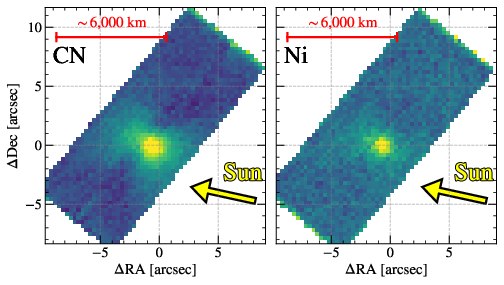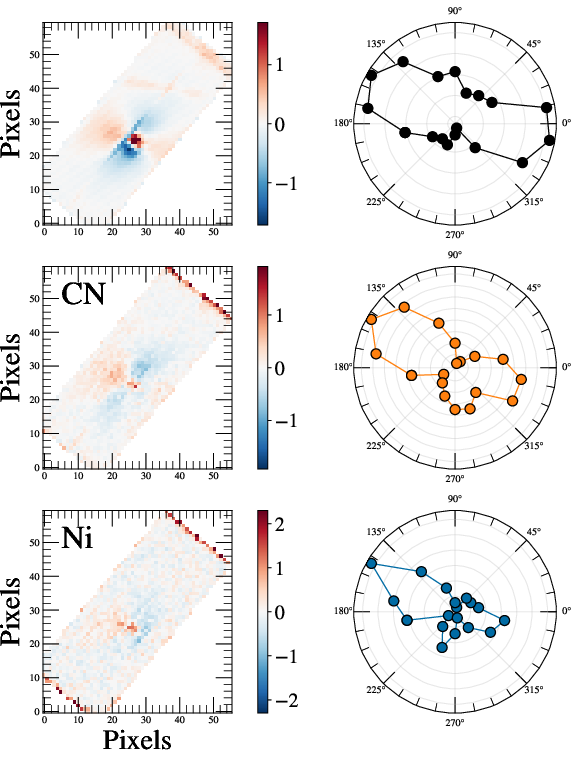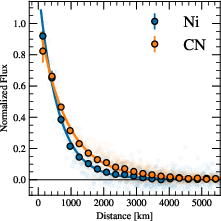Spatial Profiles of 3I/ATLAS CN and Ni Outgassing from Keck/KCWI Integral Field Spectroscopy (2510.11779v1)
Abstract: Cometary activity from interstellar objects provides a unique window into the environs of other stellar systems. We report blue-sensitive integral field unit spectroscopy of the interstellar object 3I/ATLAS from the Keck-II-mounted Keck Cosmic Web Imager on August 24, 2025 UT. We confirm previously reported CN and Ni outgassing, and present, for the first time, the radial profiles of Ni and CN emission in 3I/ATLAS. We find a characteristic $e$-folding radius of $593.7\pm14.8$ km for Ni and $841.0\pm15.4$ km for CN; this suggests that the Ni emission is more centrally concentrated in the nucleus of the comet and favors hypotheses involving easily dissociated species such as metal carbonyls or metal-polycyclic-aromatic-hydrocarbon molecules. Additional integral field spectroscopy after perihelion will offer a continued opportunity to determine the evolution of the radial distributions of species in interstellar comet 3I/ATLAS.
Paper Prompts
Sign up for free to create and run prompts on this paper using GPT-5.
Top Community Prompts
Explain it Like I'm 14
Overview
This paper studies an interstellar comet called 3I/ATLAS—an object that came from outside our solar system. The researchers used a powerful instrument on the Keck-II telescope to look closely at the comet’s “coma,” the fuzzy cloud of gas and dust around it. They focused on two gases: CN (a molecule related to carbon and nitrogen) and Ni (nickel atoms), to understand what the comet is made of and how its gases spread out from the center.
Key Objectives
The paper aimed to answer simple but important questions:
- Is the comet releasing CN and Ni gas, and how strong are those signals?
- How are CN and Ni spread around the comet—do they glow more near the center or farther out?
- What can this pattern tell us about the molecules that release nickel into the coma?
- How does 3I/ATLAS compare to other comets, including the previous interstellar one, 2I/Borisov?
Methods and Approach
To explore the comet’s gases, the team used “integral field spectroscopy” with the Keck Cosmic Web Imager (KCWI):
- Think of this tool like a camera that doesn’t just take a picture—it also records a tiny rainbow (spectrum) at every point in the image. This lets scientists see what chemicals are present and where they are located around the comet.
- The comet’s own sunlight-reflected glow can hide the gas signals. To subtract this “glare,” they used a star that looks like the Sun (a “solar analog”) and removed the reflected light, leaving behind the faint glow from CN and Ni gas.
- They made narrow “color” images at the exact wavelengths where CN and Ni shine, and then measured how the brightness changes as you move away from the comet’s center. This is called a “radial profile.”
- They fitted a simple curve called an exponential decay, which tells how fast the glow fades with distance. The “e-folding radius” is the distance where the brightness drops to about 37% of its original value (since ). A smaller e-folding radius means the glow is more tightly packed near the center.
- Using a standard comet gas model, they also estimated how many CN molecules the comet releases per second.
Main Findings
Here are the key results from the observations:
- The comet is clearly releasing both CN and Ni gas. CN forms part of the typical comet chemistry, while Ni is a metal atom that’s surprisingly found in the gas.
- Nickel’s glow is more concentrated near the comet’s center than CN. The e-folding radius is about 594 km for Ni and 841 km for CN. In simple terms, Ni fades faster as you move away from the nucleus.
- CN shows a wider, more extended coma and looks brighter along the direction toward the Sun and away from the Sun—like a jet or tail pattern. Ni is more centrally symmetric, without strong one-sided jets in these data.
- Iron (Fe) gas, which sometimes shows up with Ni in other comets, was not detected here in this observation. The team set a strict upper limit on how bright Fe could be in their data.
- The comet’s CN release rate is about 9.1 × 1022 molecules per second, a way of quantifying its activity level.
- The pattern of Ni being tightly concentrated suggests it comes from “short-lived” parent molecules that break apart quickly when exposed to sunlight.
Why These Results Matter
These findings help scientists figure out what kinds of molecules are carrying nickel in comets and how those molecules behave:
- One idea is that nickel is released from metal carbonyls, especially Ni(CO)4, which can break apart easily when sunlight hits them, causing a tight, central glow.
- Another idea is that nickel is attached to special carbon ring molecules (called PAHs) and gets knocked off by light near the nucleus.
- A hybrid idea is that nickel comes from minerals (like nickel sulfides) that get processed in the presence of carbon monoxide (CO), forming Ni(CO)4 right near the surface, then quickly breaking apart.
The fact that Ni is centrally concentrated supports explanations involving easily broken molecules. Also, compared to many solar system comets, interstellar comets like 2I/Borisov and 3I/ATLAS seem to have higher Ni-to-Fe ratios and unusual amounts of metals relative to water, pointing to different chemical histories.
Implications and Potential Impact
This work gives us a peek into the chemistry of planetary systems beyond our own:
- By measuring how gases like CN and metals like Ni are distributed, scientists can trace the “parent” molecules and the conditions that formed them in other star systems.
- Future observations of 3I/ATLAS after it passes closest to the Sun (perihelion) may show how these gas patterns change with heating.
- As telescopes discover more interstellar comets, researchers can compare many objects to see trends—like how metal content changes with distance from the Sun or varies across different birthplaces.
- In the long run, these studies help answer bigger questions about how planets and small bodies form, and what kinds of materials are common in other solar systems.
Knowledge Gaps
Knowledge gaps, limitations, and open questions
The paper advances IFU-based spectrospatial analysis of 3I/ATLAS but leaves several uncertainties and unexplored aspects that future work can address:
- Single-epoch dataset: the evolution of CN and Ni spatial profiles with heliocentric distance (pre-/post-perihelion) remains unknown; multi-epoch IFU mapping is needed.
- Limited field of view: radial profiles are truncated at ~3 arcsec (~5700 km) by chip edges; deeper, wider-FoV IFU observations are required to capture the full CN coma extent and constrain scale lengths more robustly.
- Seeing/PSF not characterized or deconvolved: the reported e-folding radii may be biased by atmospheric and instrumental blurring; measure the PSF and apply deconvolution or forward modeling to recover intrinsic radial profiles.
- Continuum contamination in 2D narrow-band maps: per-spaxel continuum subtraction is not described for CN and Ni images, risking artificial central concentration; generate continuum-subtracted line maps before spatial analysis.
- Instrumental residual (“strap”) through the comet’s center: its effect on central flux and derived radial profiles is not quantified; mask or model the artifact and propagate associated systematics.
- Exponential radial fits lack physical basis: replace with Haser/vectorial models (parent–daughter lifetimes, photochemistry, outflow) and include anisotropic outgassing to interpret CN and Ni distributions physically.
- No uncertainties or significance reported for e-folding radii: provide statistical errors and systematic budgets (PSF, background, continuum subtraction, annulus choice) and assess whether the ~200 km Ni vs. CN difference is significant.
- Azimuthal averaging despite clear anisotropies: compute sectoral (sunward, anti-sunward, perpendicular) radial profiles, quantify jet position angles and strengths, and evaluate their impact on production rates and scale-length fits.
- CN production rate assumptions: isotropic flow, g-factors, and scale lengths adopted from solar-system comets may not be optimal for an interstellar comet; recalculate g-factors for the specific r_h and velocity, and test anisotropy-aware production models.
- Fe I non-detection only yields a flux upper limit (no Q(Fe)): stack multiple Fe lines, use matched-filter techniques, and convert limits to Q(Fe) to directly compare Ni/Fe and test anomalous metal ratios.
- Band-integration approach for CN and Ni (fixed wavelength windows): resolve and fit individual lines to avoid blending and to separate line emission from continuum, improving spatial purity of maps and production-rate estimates.
- Lack of direct outflow velocity measurement: expansion speed is adopted from empirical scaling; attempt velocity constraints from line profiles (if feasible) or complementary high-res spectroscopy to reduce model dependence in scale-length inference.
- No quantitative linkage between measured Ni scale length and proposed parent chemistry: compute photodissociation lifetimes and expected spatial scales for Ni(CO)4 and Ni–PAH at 2.75 au (with realistic solar spectrum and coma conditions) to discriminate scenarios.
- Ni symmetry vs. hybrid carbonylation expectations: if in-situ carbonylation requires CO jets, search for subtle Ni anisotropies via sectoral analyses and correlate with CO/CO2 imaging/spectroscopy at matched epochs.
- CN parent species not constrained: measure HCN, HNC, and other CN-bearing parents contemporaneously to interpret Q(CN) and spatial distributions in 3I/ATLAS.
- Redward spectral constraints absent: no sensitivity limits reported beyond 4050 Å despite coverage to 5500 Å; quantify detection limits for NH2, C2, [O I] to strengthen compositional context.
- Non-contemporaneous Q-ratio comparisons: Q(Ni), Q(CO), Q(CO2), Q(H2O), and Q(CN) are drawn from different epochs/instruments; coordinate simultaneous multiwavelength campaigns to derive secure ratios and their r_h dependence.
- Plasma-tail and solar-wind effects unmodeled: incorporate magnetohydrodynamic/plasma-tail modeling to interpret anti-solar flux excess and disentangle gas vs. dust dynamics in the observed anisotropies.
- SNR and calibration systematics not reported: provide per-band SNRs, absolute flux calibration uncertainties, and tests of dust-reflectance models (beyond second-order polynomials) to bound weak-line detectability and continuum-subtraction biases.
- Population-level context speculative: define standardized metrics and selection effects to compare interstellar comets with solar-system comets; plan surveys to map Ni/Fe/CN ratios versus heliocentric distance and activity drivers across a sample.
Practical Applications
Immediate Applications
The following applications can be deployed now by leveraging the paper’s findings and methods (CN/Ni detections, radial e-folding profiles, spectro-spatial IFU analysis, continuum-removal workflow, and anisotropy diagnostics).
- IFU-based cometary coma profiling and production-rate estimation
- Sector: academia, observatories, software
- What: Apply integral-field spectroscopy (IFU) to measure azimuthally averaged radial profiles and anisotropies of cometary species; convert CN fluxes to Q(CN) via a Haser model; set upper limits for non-detections (e.g., Fe).
- Products/workflows:
- A Python “ComaProfiler” workflow (notebooks or a PypeIt plug-in) that performs: (1) solar-analog continuum removal with polynomial reflectance fitting; (2) narrow-band cube extraction around diagnostic bands (e.g., 3605–3625 Å for Ni, 3865–3885 Å for CN); (3) exponential e-folding fits with sigma-clipping; (4) model–data azimuthal residual maps to flag jets/asymmetries; (5) Haser-model Q(CN) estimation.
- Assumptions/dependencies: Validity of adopted g-factors and scale lengths; use of a suitable solar analog; access to IFU instruments (KCWI/MUSE-like) with sufficient blue sensitivity; adequate SNR and seeing.
- Rapid-response observing playbooks for interstellar comet follow-up
- Sector: observatories, academia, policy (program management)
- What: Standardize alert-to-observation procedures for objects like 3I/ATLAS to ensure blue coverage (CN, Ni), pre-/post-perihelion cadence, and field-of-view sufficient to capture coma asymmetries.
- Products/workflows: Checklists for instrument configuration (grating, central λ, slicer choice), aperture strategy, and narrow-band windows; LSST-triggered scheduling templates; cross-facility coordination notes (e.g., KCWI + JWST/near-IR volatiles).
- Assumptions/dependencies: Timely alerts (e.g., LSST brokers), flexible queue scheduling, access to blue-sensitive spectrographs.
- Spectro-spatial plume analytics for Earth observation and industrial monitoring
- Sector: energy, environmental monitoring, software
- What: Transfer the paper’s radial-profile and azimuthal-asymmetry methods to airborne/satellite hyperspectral data to estimate source strengths and effective lifetimes of terrestrial plumes (e.g., CH4 leaks, SO2, NOx).
- Products/workflows:
- “IFU-Plume” analytics module: e-folding-length fitting around point sources; wind-aligned azimuthal excess mapping; source–sink inversion using simple exponential kernels.
- Assumptions/dependencies: Comparable spatial sampling and SNR in EO sensors; approximate steady-state plumes; adaptation of photochemical lifetimes to terrestrial species.
- Training and education assets on 3D spectral cubes and comet chemistry
- Sector: education, outreach
- What: Course modules and student labs demonstrating continuum subtraction, narrow-band imaging from cubes, and retrieval of production rates.
- Products/workflows: Annotated Jupyter notebooks using public IFU data; small projects on anisotropy detection and exponential profile fitting.
- Assumptions/dependencies: Availability of example data cubes and reference solar analog spectra; basic Python environment.
- Target-selection heuristics for mission concept studies (e.g., Comet Interceptor-class missions)
- Sector: space mission planning, policy
- What: Use Ni vs. CN detectability and radial compactness as a proxy for short-lived parent species and volatile drivers to prioritize follow-up and inform payload spectral requirements (ensure blue coverage for Ni/CN, sensitivity to metal carbonyls).
- Products/workflows: Decision matrices linking detectable Ni/CN and their e-folding radii to likely parent chemistry and required instrument bands.
- Assumptions/dependencies: Community consensus that observed Ni compactness indicates short-lived parents; mission trades balancing blue sensitivity against other constraints.
Long-Term Applications
These applications require further research, scaling, or technological development, building on trends highlighted by the paper (e.g., compact Ni profiles, high Ni/CN, evolving Fe/Ni detectability with heliocentric distance, LSST-driven sample growth).
- Population-level chemometric atlas of interstellar comets
- Sector: academia, policy (facility investment)
- What: With LSST discoveries, build a statistical map of Ni/Fe/CN abundance ratios and e-folding radii vs. heliocentric distance to infer parent chemistry and extrasolar disk metallicities.
- Products/workflows: A shared database linking IFU-derived spatial diagnostics, production rates, and line ratios; meta-analysis pipelines for trend discovery.
- Assumptions/dependencies: LSST detection rates; sufficient blue-sensitive follow-up; consistent g-factors and velocity laws; robust cross-instrument calibration.
- Payload and instrument design targeting metal carbonyls and PAH complexes
- Sector: space instrumentation, robotics, materials/chemistry
- What: Design blue/UV-sensitive IFUs and in situ mass spectrometers tuned to Ni(CO)4, Fe(CO)5, and Ni–PAH complexes; optimize for detection thresholds implied by compact Ni emission.
- Products/workflows: Instrument concepts for smallsats/ride-shares; on-chip processing for moving-target cubes; lab-calibrated response curves for carbonyl/PAH signatures.
- Assumptions/dependencies: Laboratory cross-sections and g-factors for target species; survivability of carbonyls/PAHs in cometary environments; mission opportunities.
- Inverse modeling frameworks linking radial profiles to parent species and photophysics
- Sector: academia, software, EO analytics
- What: Develop physics-informed and ML-assisted retrievals that infer parent species lifetimes, branching ratios, and source regions from spectro-spatial profiles and anisotropy patterns.
- Products/workflows: Open-source toolkits that jointly fit multi-species cubes (Ni, Fe, CN, OH) with solar directionality and velocity laws; adaptation to Earth plume inversions.
- Assumptions/dependencies: Accurate photodissociation/fluorescence data; validated gas-dynamics models beyond Haser (e.g., anisotropic ejection, jetting, radiation pressure).
- Laboratory astrochemistry program on metal–carbonyl and metal–PAH stability
- Sector: academia, materials/chemistry
- What: Measure formation pathways, stability, and photolysis rates of Ni(CO)4/Fe(CO)5 and Ni–PAH complexes under comet-like UV fields, temperatures, and CO/CO2/H2O mixes.
- Products/workflows: Updated g-factors and scale lengths; validated mechanisms to distinguish carbonyl vs. PAH vs. hybrid “in situ” formation scenarios.
- Assumptions/dependencies: Facility access (synchrotron/UV lamps, cryo-chambers); representative analog materials; cross-lab standardization.
- Space resource prospecting concepts informed by metal signatures
- Sector: space resources, finance, risk management
- What: Use Ni/Fe emission diagnostics and spatial profiles as remote proxies for metal content and processing state of small bodies; integrate into techno-economic models for resource targets.
- Products/workflows: Target-scoring indices combining spectral lines, e-folding radii, and volatile drivers; risk assessments for encountering toxic carbonyls (e.g., Ni(CO)4).
- Assumptions/dependencies: Correlation between gaseous Ni/Fe indicators and extractable metal abundance; maturing in situ verification.
- Compact IFU spectrographs for small telescopes and cubesats
- Sector: instrumentation, software
- What: Develop low-mass, blue-sensitive IFUs with on-board reduction tailored to moving targets to democratize comet spectro-spatial surveys.
- Products/workflows: Reference designs; FPGA/edge pipelines for continuum removal, narrow-band slicing, and profile fitting in flight.
- Assumptions/dependencies: Detector QE in blue/UV; stray-light control; pointing/tracking performance.
- Policy frameworks for rapid interstellar-object characterization
- Sector: policy, research infrastructure
- What: Establish funding and coordination protocols that prioritize blue-sensitive IFU time shortly after ISO discovery; standardize data/metadata formats for rapid community analysis.
- Products/workflows: Memoranda of understanding across observatories; alert-broker hooks that auto-generate recommended configurations and exposure calculators.
- Assumptions/dependencies: International coordination; sustainable operations budgets; data rights and rapid-release policies.
- Cross-domain environmental analytics inspired by comet methods
- Sector: environmental monitoring, energy, insurance
- What: Commercial analytics platforms that estimate emission rates/lifetimes and detect directional excesses using exponential radial kernels and azimuthal residual maps, adapted from comet analysis.
- Products/workflows: Methane leak analytics that fuse hyperspectral cubes with wind fields to produce actionable leak localization and severity estimates.
- Assumptions/dependencies: Reliable wind and transport models; sensor access; validation datasets for different terrains and sources.
Glossary
- Anti-solar tail: A cometary tail pointing directly away from the Sun due to solar radiation and wind; often aligns with the anti-solar direction. "3I/ATLAS has indeed developed an anti-solar tail as of late August."
- Anti-velocity directed cometary tails: Tails oriented opposite to the comet’s motion, shaped by radiation pressure and plasma interactions. "anti-velocity directed cometary tails are spread out by a combination of radiation pressure, solar wind gas drag, and ionic interactions with the interplanetary magnetic field."
- Anisotropy: Direction-dependent variation in brightness or distribution, indicating asymmetry. "Figure \ref{fig:KCWI_whitelight_comp} also shows anisotropy in the distribution of CN"
- Arcsec: An angular unit (1/3600 of a degree) used for measuring small angles on the sky. "The aperture is the 3\arcsec\ aperture we used to extract our 1D spectrum."
- Azimuth: The angular coordinate around the comet used to describe direction-dependent features. "Right: Model-subtracted flux excess as a function of azimuth."
- Azimuthally averaged flux: Flux averaged over all angles at a given radius to produce a radial brightness profile. "The azimuthally averaged flux as a function of physical radial distance is shown in Figure \ref{fig:KCWI_profiles}."
- BL grating: A specific diffraction grating used in the blue channel of a spectrograph to disperse light by wavelength. "The blue channel used the BL grating, providing a spectral resolving power of ."
- Carbonylate: To form a metal carbonyl by binding carbon monoxide (CO) to a metal. "these sulfides carbonylate to ."
- Coma: The diffuse envelope of gas and dust surrounding a comet’s nucleus formed by sublimating ices. "When a comet warms, its volatile ices sublimate, lifting dust off the surface and creating the coma."
- Continuum-subtracted spectrum: A spectrum from which the smooth background (continuum) has been removed to isolate emission or absorption features. "Figure \ref{fig:spec1d} shows the 3425 \AA\ to 4050 \AA\ 1D continuum-subtracted spectrum from our KCWI datacube."
- Dithering: Moving the spectrograph slit between positions to sample spatial variations and mitigate systematics. "Slit-based techniques for studying radial distributions for comets involve dithering the slit between a central position and an offset position."
- e-folding radius: The characteristic length scale over which an exponential profile decreases by a factor of e. "We find a characteristic -folding radius of $593.7 km for Ni and$841.0 km for CN;"
- Expansion speed: The velocity at which gas expands outward from the comet’s nucleus. "adopted a mean expansion speed of ~km~s"
- Flux calibration standard: A star with known brightness used to convert instrumental counts to physical flux units. "We obtained a KCWI spectrum on UTC 2025-08-24 06:06:49 (observation midpoint), along with two solar analogs and a flux calibration standard."
- Flux upper limit: The maximum flux consistent with non-detection, often reported at a confidence level. "The flux upper limit of the \ion{Fe}{1} 3720 feature is {\,erg\,s\,cm\,\AA}."
- g-factor: The photon emission rate per molecule per second used to convert line flux to production rates. "The number of photons emitted per molecule per second (the so-called g-factor)"
- Geocentric distance: The distance from Earth to the comet, typically measured in astronomical units (au). "3I/ATLAS was at a heliocentric and geocentric distance of 2.75 and 2.60 au"
- Gaussian emission feature: A model emission line with a Gaussian profile used for fitting or setting limits. "we insert a 3 Gaussian emission feature."
- Heliocentric distance: The distance from the Sun to the comet, typically measured in astronomical units (au). "3I/ATLAS was at a heliocentric and geocentric distance of 2.75 and 2.60 au"
- Hyperbolic orbits: Trajectories with eccentricity greater than 1 indicating an unbound, interstellar passage through the solar system. "Interstellar objects (comets and asteroids that pass through the solar system on hyperbolic orbits)"
- Integral-field unit (IFU): A spectroscopic technique that captures spatially resolved spectra across a 2D field. "Here, we present integral-field unit (IFU) observations of 3I/ATLAS"
- Interplanetary magnetic field: The Sun’s magnetic field carried by the solar wind, influencing cometary plasma tails. "ionic interactions with the interplanetary magnetic field."
- Isotropically: Emitted equally in all directions from the source. "We assumed that the gas escapes isotropically from the nucleus at a constant velocity,"
- Keck Cosmic Web Imager (KCWI): A spectrograph on the Keck-II telescope that provides IFU observations, especially in the blue. "Here, we present integral-field unit (IFU) observations of 3I/ATLAS from the Keck Cosmic Web Imager (KCWI; \citealp{Morrissey18})"
- Legacy Survey of Space and Time (LSST): A wide-field survey at the Vera C. Rubin Observatory designed to discover transient and moving objects. "The upcoming Legacy Survey of Space and Time \citep{LSST_2019} will discover and observe more interstellar comets"
- Metal carbonyls: Compounds where CO ligands bind to metals (e.g., Ni(CO)4), potentially releasing metals upon dissociation. "metal carbonyls, such as and , are present in the comet"
- Narrow-band images: Images integrated over small wavelength ranges to isolate specific spectral features. "Comparison of narrow-band images from the KCWI data cube for CN (left, from 3865\AA\ to 3885\AA) and Ni (right, from 3605 \AA\ to 3625 \AA)."
- Non-gravitational acceleration: Changes in a comet’s motion not explained by gravity, typically due to asymmetric outgassing. "However, the only possible explanation for the non-gravitational acceleration of 1I/ was due to outgassing by CO or CO"
- Nuisance parameters: Fit parameters included to account for systematic differences but not of direct physical interest. " and are nuisance parameters that account for the relative motion between Earth and the comet and Earth and the solar analog star"
- Outgassing: Release of gas from a comet’s nucleus as ices sublimate, driving activity. "As it approached perihelion, outgassing increased."
- Perihelion: The point in a comet’s orbit closest to the Sun. "As it approached perihelion, outgassing increased."
- Photodissociation: The breaking of chemical bonds by absorption of photons, producing atomic or molecular fragments. "The subsequently undergoes a similar photodissociation as the metal-carbonyl model described above."
- Photofragment: To break a molecule into smaller parts due to photon absorption. "metal-polycyclic aromatic hydrocarbons \citep[PAH,] []{Tielens08} that photofragment and release Ni and PAHs;"
- Polycyclic aromatic hydrocarbons (PAH): Large, planar organic molecules made of fused aromatic rings, common in astrophysical environments. "metal-polycyclic aromatic hydrocarbons \citep[PAH,] []{Tielens08}"
- PypeIt: A Python package for reducing astronomical spectroscopic data. "We reduced our KCWI data following standard PypeIt procedures"
- Q(Ni)/Q(CN) ratio: The ratio of production rates (number of molecules per second) for Ni and CN, used to compare abundances. "The Q(Ni)/Q(CN) ratio from \citet{Rahatgaonkar2025} is 0.1,"
- Radiation pressure: Force exerted by photons that pushes dust and affects tail morphology. "spread out by a combination of radiation pressure, solar wind gas drag, and ionic interactions with the interplanetary magnetic field."
- Radial profiles: Brightness or flux as a function of distance from the comet nucleus used to study spatial distributions. "We present, for the first time, the radial profiles of Ni and CN emission in 3I/ATLAS."
- Resonance fluorescence: Re-emission of absorbed sunlight at specific wavelengths by gas molecules. "Sunlight excites these gas molecules, which then re-emit light by resonance fluorescenceârevealing the composition of the volatiles."
- RMS scatter: Root-mean-square deviation used to quantify noise or variability in spectral data. "We use the sigma-clipped RMS scatter of our continuum-subtracted spectrum as the 1 value."
- sigma-clipped: A statistical technique that removes outliers beyond a set standard-deviation threshold before refitting. "after each fit, outliers are sigma-clipped, and the sigma-clipped data are refit."
- Signal-to-noise ratio (SNR): A measure of data quality comparing signal strength to noise level. "The solar analog has high SNR, so the continuum-subtraction contribution to the error budget is negligible."
- Slit loss: Photons missing the spectrograph slit due to misalignment or finite slit width, reducing measured flux. "including no slit loss of photons"
- Solar analog: A star with a spectrum similar to the Sun used for calibrations and continuum modeling. "To subtract the solar continuum contribution, we use HD~165290 as a solar analog."
- Solar wind gas drag: Momentum transfer from the solar wind plasma that influences cometary gas tails. "spread out by a combination of radiation pressure, solar wind gas drag, and ionic interactions with the interplanetary magnetic field."
- Spectral resolving power: A spectrograph’s ability to distinguish close wavelengths; defined as R = λ/Δλ. "providing a spectral resolving power of ."
- Sun-to-target radius vector: The geometric vector from the Sun to the comet, used to define solar/anti-solar directions. "The extended sun-to-target radius vector is 102.7 degrees."
- Thermochemical erosion: Material removal via thermally driven chemical reactions, potentially releasing atoms from minerals. "The hybrid scenario invokes UV sputtering or thermochemical erosion to produce Ni atoms"
- UV sputtering: Ejection of atoms or molecules from a surface due to ultraviolet photon interactions. "The hybrid scenario invokes UV sputtering or thermochemical erosion to produce Ni atoms"
- Whitelight image: An image integrated over a broad wavelength range to show overall structure. "3425 \AA\ to 5500 \AA\ whitelight image from the KCWI data."
Collections
Sign up for free to add this paper to one or more collections.
